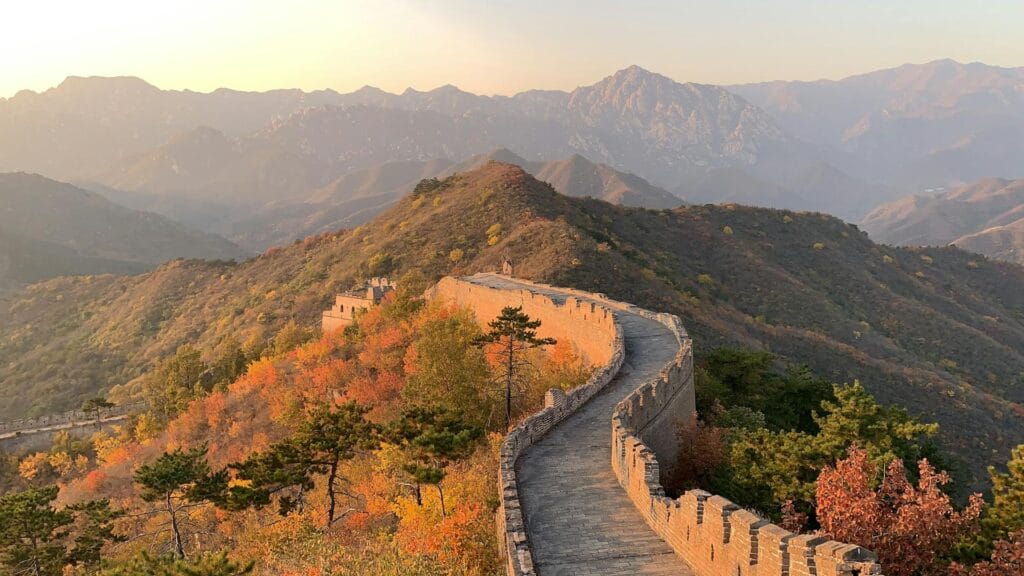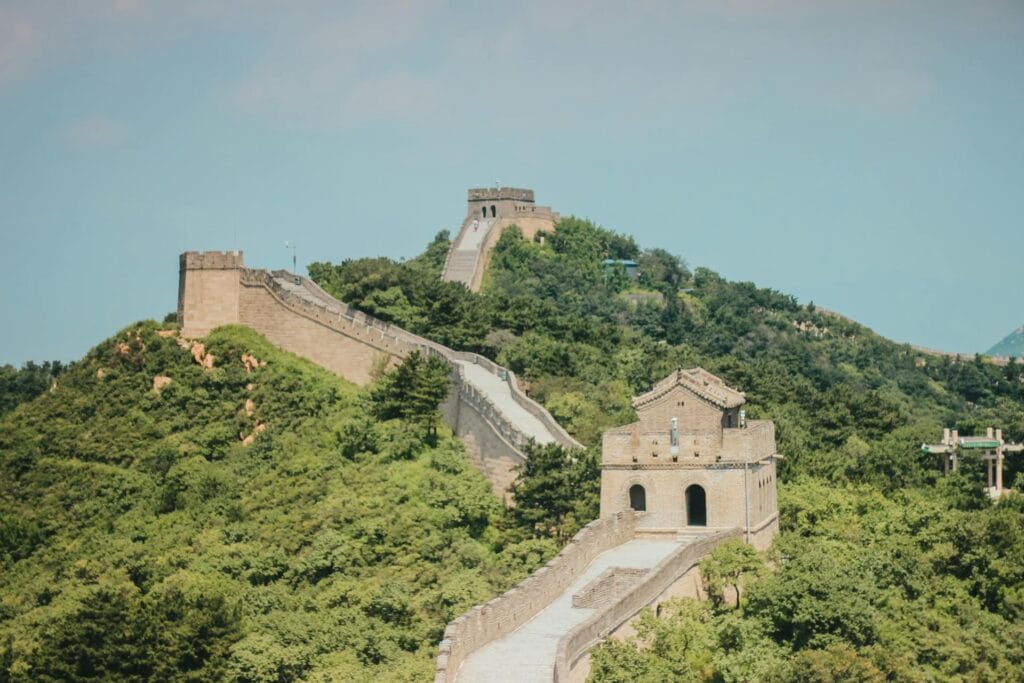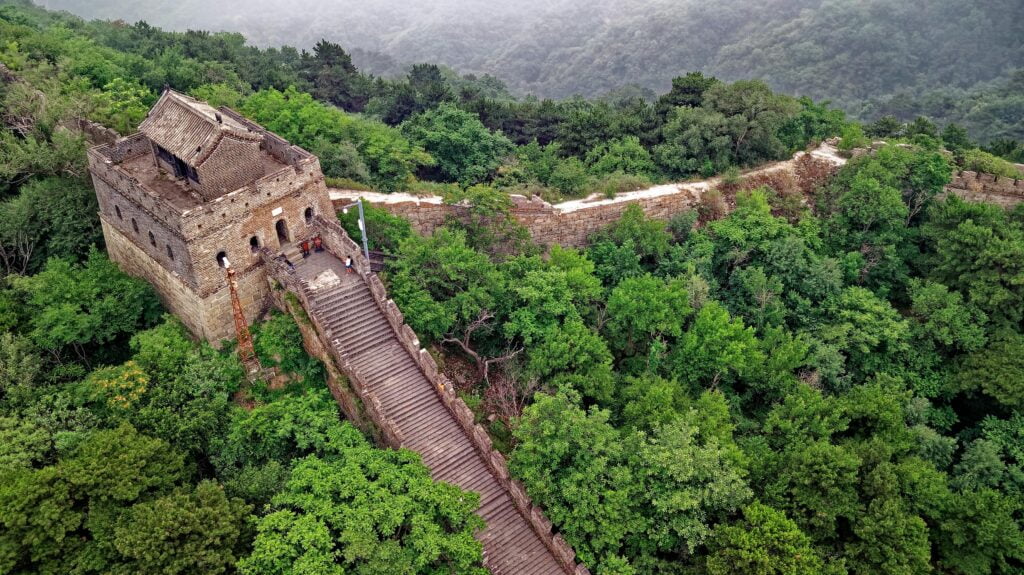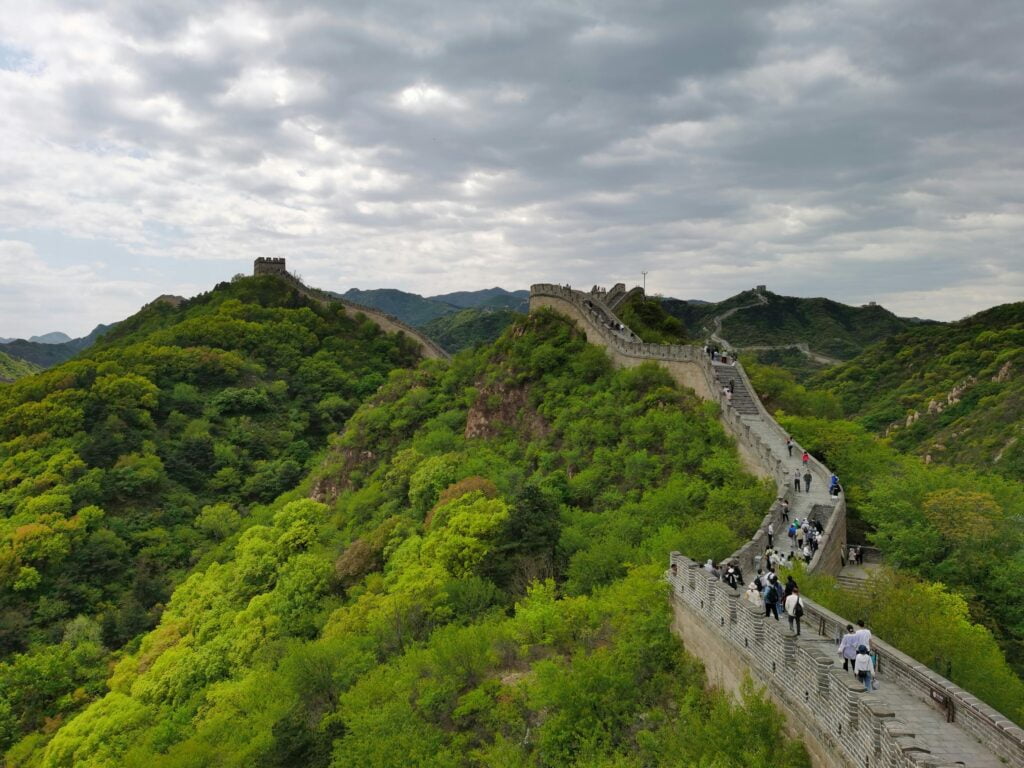Great Wall of China
The Great Wall of China is a popular landmark that represents the country’s deep history and cultural significance. This impressive wall stretches more than 13,000 miles and was originally built to keep out invaders from the north. The Great Wall of China shows the country’s strength and pride in its culture. This amazing structure runs across northern China, starting at Shanhaiguan Pass in the east and ending at Jiayuguan in the west. The wall goes through mountains, deserts, and grassy fields, highlighting the beautiful landscapes of the area.
The Great Wall of China is a significant historical landmark. It protected the country and showcases the amazing skills of the ancient Chinese builders who built it. Construction of the Wall started as early as the 3rd century B.C. and continued over many years, with significant improvements made during the Ming dynasty, which gave us the version of the Wall we see today. Its impressive design and construction highlight the ingenuity of those who built it.
The Great Wall of China is a stunning example of ancient military design. It shows how different groups of people, like farmers and nomads, interacted over time while highlighting the goals and visions of various Chinese empires. Today, this incredible structure draws millions of visitors from around the globe, giving them a chance to explore China’s rich history and admire the amazing accomplishments of its people.
Table of Contents
Where is the location of the Great Wall?

The Great Wall of China is breathtaking structure that runs across northern China, starting from a place called Shanhaiguan in the east and ending at Jiayuguan in the west. It goes through several provinces like Hebei and Gansu. The Wall moves through various landscapes, including mountains, deserts, and fields, providing stunning views and showcasing the deep history of China.
Inscription
The Great Wall of China change into a UNESCO World Heritage Site in 1987. This means it is recognized for its cultural and historical important. This honor highlights the Wall as an impressive architectural achievement and a reminder of China’s rich history. Not only does the Wall stretch over 13,000 miles, but it also represents the strength and determination of the Chinese people throughout the ages.
The Great Wall is an amazing structure with towers and defenses that showcase incredible building skills. Because it’s recognized by UNESCO, more people around the world are becoming aware of its significance, which helps push efforts to preserve this historic landmark. The Wall not only inspires and educates people today but will also do so for future generations, highlighting its importance in culture and history.
What is the history of the Great Wall of China?

In this period of Qin Shi Huang, the first emperor of China, different sections of earlier walls were joined together to form a strong defense system against attacks from the north around 220 B.C. The building of what we now know as the Great Wall continued for many years, reaching its peak during the Ming dynasty from 1368 to 1644. The Great Wall of China was the most important military structure in the world during this time. Its historical importance, strategic benefits, and impressive design show how advanced ancient China was in protecting its people and land.
The Great Wall of China is a remarkable structure that was built over many centuries, starting from the 3rd century B.C. and continuing until the 17th century A.D. It stretches more than 20,000 kilometers along the northern border of the country. This incredible wall was created as a defense system by various Chinese Empires and serves as a symbol of strength.
The Great Wall of China begins at Shanhaiguan in eastern Hebei and ends at Jiayuguan in western Gansu. It is more than just a wall; it has paths for horses, tall towers for watching the surroundings, shelters for travelers, and strongholds for protection. Overall, it is an amazing historical structure that shows the creativity and hard work of the people who built it. Today, the Great Wall continues to be a powerful symbol of China’s history and culture, appreciated for its unique global significance.
Why was the Great Wall of China built for?
The Great Wall of China is an important symbol in the country’s history. It was built to protect China from outside threats and to preserve its cultural heritage against foreign influences. Building the wall was a tough job that shows the difficulties people faced back then. This idea of working hard and making sacrifices appears in many types of Chinese literature. For example, you can find it in old poems and famous stories from the Ming dynasty, like “The Soldier’s Ballad” by Tch’en Lin and the poems written by the poet Tu Fu.
The Great Wall of China is an incredible symbol of the country’s rich history. It highlights the hard work of ancient Chinese people, especially the strong earth walls built a long time ago during the Western Han dynasty in what is now Gansu province. Later on, during the Ming dynasty, the wall was strengthened with beautiful stone, which many people admire today for its impressive design and durability.
Architecture the Great Wall

The Great Wall, which was built through the Ming Dynasty, is truly incredible! It’s more than just a huge construction project; it’s a wonderful mix of art and creativity. What makes the wall so special is how well it was built and how beautifully it fits into the lovely scenery around it. This famous wall is unique because it is the only man-made structure that stands out so wonderfully amid the vast scenery of the continent.
During the Chunqiu period, the Chinese implemented their methods for building and organizing spaces, especially when creating defensive structures along the northern border. The movement of people involved in building the Great Wall also helped to spread Chinese culture and influence more widely.
Cultural Significance of the Great Wall
The Great Wall is a key symbol of how different groups, like farmers and nomadic herders, worked together in ancient China. It shows the skill and creativity of the builders and artists from that time. The Wall is not just a barrier; it represents safety and pride for the nation, playing a significant role in China’s history and identity.
This fascinating cultural site features a military structure that has played an important role for 2,000 years. Its history shows us how the ways people built defenses have evolved over time, influenced by various political changes and events.
Preserving the Great Wall of China

Preservation the Great Wall of China is really important for making sure this famous historical site is preserved for future generations. The Wall is not just a structure; it represents a significant part of our history and culture. To keep it in good shape, there are efforts underway to repair it, strengthen its structure, and protect it from things like erosion and damage caused by weather or natural disasters.
Experts, such as archaeologists and conservationists, work to preserve the Wall by using traditional materials and techniques that keep its original appearance and character. They also organize educational programs to help local communities and visitors understand how important the Wall is and why it’s crucial to take care of it.
Many countries and groups from all over the world join forces to exchange ideas and resources to help protect important cultural sites, such as the Great Wall. The main goal of these efforts is to make sure that the Great Wall continues to be a powerful symbol of human creativity and strength for generations to come.
Why should you visit the Great Wall of China as a visitor?

Visiting the Great Wall of China is an incredible experience for many reasons. This amazing structure is a UNESCO World Heritage site and stretches over 13,000 miles. It shows the remarkable skills of ancient Chinese builders. The wall is surrounded by beautiful natural scenery and offers breathtaking views of nearby mountains and valleys.
Visiting different parts of the Great Wall of China allows people to enjoy beautiful scenery while discovering the country’s fascinating history and culture. Each section of the wall is uniquely designed, making it a great place to explore and snap photos. Walking along the wall can be a fun way to exercise, as some parts are steep and can be challenging. Overall, the Great Wall offers a wonderful mix of history, adventure, and natural beauty, making it a must-see spot for everyone.
Have you considered adding the Great Wall of China to your travel bucket list?
The Great Wall of China is absolutely value a visit! It not only helps you explore the fascinating history of the area, but it also provides amazing views of the beautiful landscapes around it. If you’re planning an exciting adventure, making sure to include it on your travel wish list is a great idea!
When you’re planning your adventure, enhance your travel experience by using trusted websites like GetYourGuide, Trip.com, Agoda, Expedia and Hotels.com! These platforms offer a variety of enjoyable tours, activities, and accommodation options to suit every traveler’s needs.
- GetYourGuide offers a wide variety of unforgettable travel experiences. You can choose from tickets to Popular Attractions, Transportation Options, City Passes, Guided Tours, Hop-on Hop-off Bus Services, Water Activities, Day trips, and Trips that last several days in many locations around the world.
- Trip.com makes it easy to combine Flights and Hotels, Trains, Car Rentals, Airport Transfers and Attractions & Tours to create the perfect travel package tailored just for you.
- Agoda offers a wide range of accommodations and travel options to suit your needs. With user-friendly search features, you can easily find the perfect Hotel, Apartment, or Villa, Flights, Activities and Airport Transfer at competitive prices.
- Expedia to find the perfect travel deals and begin planning your next adventure with ease. Your unforgettable trip is just a click away!
- Hotels.com today to explore incredible deals and find the perfect housing for your dream trip! Your adventure starts here!
Start your journey with our reliable travel partners and unlock the best Great Wall of China and beyond!
Disclaimer
In this post, affiliate links are included and those links are associated with well-known travel companies such as GetYourGuide, Trip.com, Agoda, Expedia and Hotels.com. If you choose to purchase or book a service using those links, we may earn a commission at no additional cost to you. We focus on recommending products and services that are helpful to you and we appreciate your support!
Conclusion
We hope you find this information helpful for your next trip. If you want to learn more, check out our other travel blog posts. We cover many topics, including amazing places to visit and helpful travel tips. Whether you’re looking for hidden gems, new cultures, or helpful advice, there’s something for everyone.
Additionally, if you enjoyed the information we shared, don’t forget to explore our other travel product reviews to make your journey even better! Please take a moment to look through our previous posts and let your sense of adventure guide you on your next journey! We wish you happy travels and look forward to sharing more with you in our next blog post!




